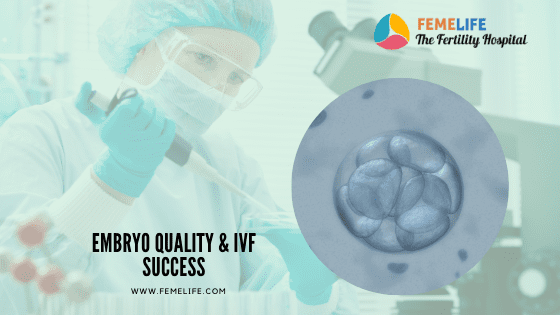During IN VITRO FERTILIZATION (IVF) your doctor would prefer to transfer the best quality embryo. In fact the embryo quality predicts your success rate in IVF treatment. IVF is a method to create embryos within the laboratory by the embryology team. The embryos have that are most effective are called best grade embryos. Fertility clinics grade the embryos with totally different language however every grading system. It enables the embryologist team to tell apart between smart, average, and poor quality embryos. Based on this your doctor will settle on the embryo for transfer that has the best IVF success.
When discussing embryo quality, embryologists and physicians are pertaining to the appearance of the embryo. However, there are varied factors that determine if the embryo is having implantation potential.
How Embryos Develop
In a natural gestation, spermatozoon fertilizes associate degree egg because it travels down the female internal reproductive organ. The cells within the fauna divide associate degreed grow into an embryo because it moves to the womb, and it implants within the womb to continue growing. In associate degree IVF cycle, fertilization and embryo development takes place within the biology research laboratory. The eggs and spermatozoon area unit combined, and also the inseminated eggs begin the method of dividing and growing.
Embryos that have grownup for 3 days within the research laboratory area unit referred to as cleavage stage embryos. Typically embryos are allowed to grow for 5 days before transfer. These units are referred to as blastocysts. Once the embryos area unit prepared, a generative specialist can transfer the most effective quality embryo(s) to your womb. you may agree on the amount to be transferred. Typically no over 2 embryos, before the procedure takes place. Then, if all goes well, one in every of the embryos can implant in your womb and grow into a baby.
Cell variety and Quality of Embryo
An embryo that’s dividing well ought to ideally have between half-dozen to ten cells by day three. ResearchTrusted supply shows that eight is best. (Day three embryos that had eight or additional cells showed a considerably higher nativity rate).
However, not all sensible quality embryos follow the principles. Some embryos can have three, 5, or 6 cells, and that’s as a result of cells don’t divide at identical time. So, the rule of thumb is that though things aren’t clear cut, it will appear that the quantity of cells in associate embryo is that the best indicator of whether or not associate embryo can thrive or not.
Cell look
While it’s comparatively simple to count the quantity of cells you see in an exceedingly day three embryo, cell look is more durable to grade. this is often particularly therefore as a result of typically you aren’t viewing the embryo head-on, however at a tangent. Day three embryos square measure stratified one to four (or 5) reckoning on the research laboratory protocol with one being the very best grade.
So, what square measure embryologists wanting for? They need to check that every cell incorporates a nucleus which the cells square measure of equal size.
They conjointly check for fragmentation. This generally happens once cells divide. consider the crumbs slack that cake. Up to twenty % fragmentation is okay. over that and also the cells lose an excessive amount of living substance (cell contents) for optimum perform.
Grading Day three Embryos
Clinics that grade embryos on day three of growth generally use a grading system ranking the embryos on a scale of one five|to five} with one being the simplest (some clinics might use 5 because the best). Day three embryos ideally include 6-8 cells command at intervals associate outer “shell” referred to as the zone. At this stage of development, embryos square measure ranked on:
Rate of growth
Degree of Fragmentation
Embryo Quality on Day 5
From day three to day five, some embryos can grow into blastocysts. The cells in these embryos begin to differentiate into 2 varieties of cells. Baby-making cells and placenta creating cells that surround a fluid-filled cavity. Blastula embryos that square measure ranked when five days of growth square measure ranked with a way a lot of difficult system. blastula grading is decided by:
Degree of growth supported however expanded the cavity is. This can be ranked on a scale of 2-6 with half-dozen being the foremost expanded. Appearance of the inner cell mass is more simplified. Appearance of the trophectoderm (which makes the placenta) conjointly hierarchic with A, B or C with A being the simplest.
Blastocyst Rating
Rating blastocysts follows a three-part system of grading. A simplified system to use for grading blastula success within the following chart:
NUMBER: The degree of the enlargement of the embryo’s cavity, starting from 2-6
2 = cavity which fills 1/3 of the embryos
3 = partial enlargement, fills seventieth of the embryo
4 = totally distended cavity
5 = embryo has distended and split open the body structure
6 = embryo has utterly hatched from the body structure
FIRST LETTER: The inner cell mass (ICM) quality will dertermine.
A = well-defined clump of cells
B = less well defined; is also gritty in look
C = a couple of dark cells, seem chronic
SECOND LETTER: The trophectoderm quality.
The trophectoderm is that the cell layer that produces the placenta and therefore the membranes encompassing the baby.
A = several sleek cells, equal size, forming a neat layer
B = irregular cell layer, some gritty cells
C = terribly irregular cell layer, cells is also dark and/or gritty
In this methodology of grading, Associate in Nursing embryo grade of 4AA, as an example, would be a blastula of excellent look.

